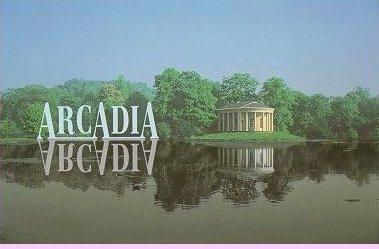
Make love not sex or
Et in Arcadia Ego
It would only be a question of time for Stoppard to pop up in this blog. And not because of his Oscar-winning film script for “Shakespeare in Love”. In fact, the most significant epiphany in my life, with a clarity of recollection that is similar to other people’s “where-were-you-when –Kennedy-was-shot?” took place on Friday 16 April 1993. In the Lyttelton Theatre, at the NT (The Royal National Theatre), London, around 10 pm. (I’ll call my own bluff: I have in front of my eyes the ticket for Stalls, row R seat 17, for a performance of “Arcadia” who had opened 3 days earlier).
“Arcadia” is the foremost example of the precise opposite of where cultural entertainment is been taking us in the last decade. It’s not ready-to-swallow stuff, like junk baby-food for prime-time TV viewers, and to fully savour the theatrical meal you have to be something of a gourmet. As in real life Gastronomy, beyond the pedantry and slightly intimidating plate description you end up with a personal experience that exceeds everything you ever get from just plain good food. As was put by one of the contributors to a book I read yesterday, the “cultured and culturally driven” theatre of Stoppard “will not work for slackers. Just how specialized, then is Stoppard’s audience? Look around you the next time you go to the theatre; then decide for yourself whether or not it is full of intelligentsia (not necessarily effete), the fellow Stoppardian time travellers we recognize in ourselves." (Enoch Brater’s “Tom Stoppard’s Brit/lit/crit” in ‘The Cambridge Companion to Tom Stoppard, Edited by Katherine E. Kelly’, 2001).
“Time travellers” is the critical operational concept here, for Arcadia ends up with past and present occupying the same space simultaneously. Two different sets of characters who have been living two centuries apart share for one waltzing last scene the same dance floor, seamlessly. That moving and exalting tour de force was the whamming wow!-ing moment, around 10pm in a London spring evening, I was referring to in the beginning of this post.
You have the same room in the garden front of Sidley Park, a large country house in Derbyshire, and the plot progression is alternately set in two radically different time-frames - 1809-1812 and in the present day. You do get the usual back and fro treatment, with flashback and flash-forward narrative techniques we are all quite used to. The key point though is that intertwining of the two periods (with information travelling both ways) actually culminate in both separate (epochal) plots having their resolution “simultaneously” (but two hundred years apart) in the same tri-dimensional space. (I stress the three dimensions because the stunning effect would not work in a flat screen or a movie cinema). For those brief moments, having suspended the usual belief in reality, and accepting the characters/actors as being “for real”, you are forced into a non-spacetime based reality. Time is bent and in front of the mesmerized viewer’s eyes unfolds the Newtonian “impossibility” of two separate space-time events occurring at the same moment, in that very same stage room “shared” by two centuries of difference.
Now, when a writer plays with people, directing his characters' lives towards the point he masterly ordains to, one says he’s acting as God. But when he successfully plays with Time itself, he’s no longer acting as, he becomes, in a way, God Himself.
Its probably unfair and not too clever to reduce a complex and superbly crafted play to that climactic last scene, but once you witness it you can’t help to think that the previous two and something hours are a kind of extended foreplay to the penetrative orgasmic final experience.
That, on cue, brings me to the controversial subject of the quote perfect fuck unquote. What’s the “perfect f...k” in my book? Well, it’s a very rare event that can (or cannot) take place in one’s love/sexual life around the 4th of 5th cluster of sexual mating with the partner you are in love with. It never happens in the beginning of a love affair, there’s always a learning curve regarding each other’s bodies and sexual languages. Later on, when the passionate romantic love shine has faded, it will be too late. It will have to happen while both are still madly in love with each other (this simultaneity is rather less frequent than soap-operas tend to stress) but sufficiently detached from the object of their love to be more aware and reactive to the other’s whims and pleasure tricks. If under these relative constraints aleatory circumstances produce the tumescence/wetness of their respective lifetimes, and you embark in a “parcours sans fautes” both technically and in emotional response, you find yourself in your own personal PF. You are not having sex, remember, you are making love, and you will reap the just reward, in the emotional shape of a all powerful, high-Richter scale earth-trembling unforgettable orgasmic “death”. Et in Arcadia Ego. PF indeed.
Arcadia is Theatre’s “perfect fuck”.
















